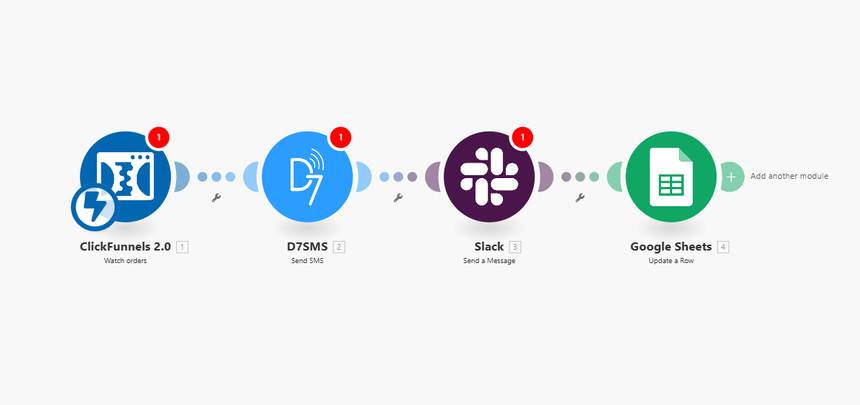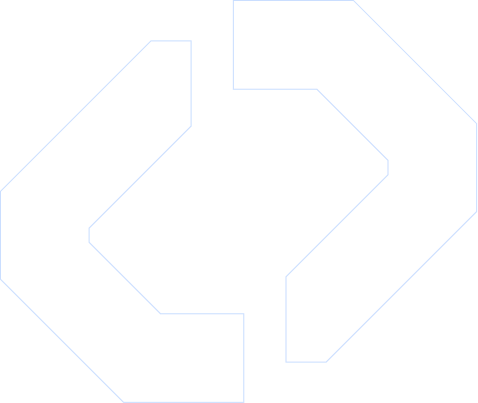ClickFunnels to Google Sheets & D7 SMS Integration with Make.com
Automate your funnel operations by connecting ClickFunnels, Google Sheets, and D7 SMS in a single Make.com workflow. This scenario captures new leads from ClickFunnels, stores them in Google Sheets, and triggers D7 SMS messages automatically—giving developers a reliable, scalable automation pattern.

How It Works
This Make.com workflow orchestrates data flow between ClickFunnels, Google Sheets, and D7 SMS, using ClickFunnels as the trigger and SMS as the final action. The goal is to ensure that every new funnel submission is logged and acknowledged via a transactional text message.
1.Trigger: New Submission in ClickFunnels
1.A visitor submits a form or completes an order in a ClickFunnels page.
2.ClickFunnels sends event data (name, email, phone, product, funnel step, etc.) to Make via the ClickFunnels module or webhook.
3.The Make.com scenario is triggered instantly or on a defined polling interval, depending on your setup.
2. Data Parsing and Validation in Make.com
1.Make.com receives the payload from ClickFunnels.
2.The workflow parses key fields:
- Lead/contact information (name, email, phone)
- Funnel identifiers (funnel ID, step, variation)
- Transaction details (order ID, product, price) where applicable
3. Optional: A router or filter verifies that the lead meets criteria for the D7 SMS integration (e.g., phone number present, specific funnel or step, country code).
3.Write to Google Sheet
1.The Google Sheets module appends a new row with normalized, structured data:
- Timestamp
- Name, email, phone
- Funnel name / ID, step name
- Product / plan
- UTM parameters or campaign IDs (if available)
2. The sheet acts as a lightweight data store, enabling easy reporting, QA, and downstream integrations.
3. Optional: A second Google Sheets step can perform lookups (e.g., deduplication, existing customer checks) before triggering SMS.
4. Trigger D7 SMS Integration
1.After a successful insert into Google Sheets, the workflow calls the D7 SMS module in Make.
2.The D7 SMS integration sends a templated text message to the lead’s phone number, using dynamic data from ClickFunnels and the sheet:
- Personalized greeting (e.g., “Hi {{first_name}}”)
- Confirmation text (e.g., opt-in, order received, booking details)
- Short links or tracking parameters, if needed
3.Optional: Configure conditional logic to send different SMS templates based on funnel step, product type, or geo-location.
5. Error Handling & Logging
1.If D7 SMS fails (e.g., invalid phone, provider error), Make.com can:
- Log an error record in a separate Google Sheets tab
- Notify a Slack/Teams channel for review
- Retry delivery according to your rules
2.Developers can leverage Make’s execution logs and run history to debug payloads, response
Key Benefits
- Robust Automation with Minimal Overhead
By using a Make.com workflow, you centralize ClickFunnels events, sheet storage, and D7 SMS integration in a single, maintainable pipeline. No custom backend code is required, yet the structure remains friendly for developers who care about observability and versioned configuration.
- Reliable Lead Capture and Audit Trail
Google Sheets provides an immediate, human-readable record of every ClickFunnels submission. This is useful for:
- Compliance and audit logs
- Manual QA and spot checks
- Quick exports to BI tools or CSV-based workflows
Having a consistent sheet schema makes downstream automation and analytics straightforward.
- Fast, Transactional SMS Delivery
Automated SMS confirms that a lead action was received and processed. With the D7 SMS integration:
- New leads get instant feedback and confirmations
- Time-sensitive offers or access links are delivered reliably
- You reduce dependency on email deliverability and inbox placement
Developers can configure message templates centrally and reuse them across funnels.
- Scalable, Configurable Make.com Workflow
The Make.com scenario is modular by design:
- Add filters, routers, and conditional branches per funnel or product
- Enrich data via additional APIs before logging or sending SMS
- Integrate with more apps (CRM, payment gateways, support tools) without rewriting the core pipeline
This makes the automation scalable for multiple brands, workspaces, or client accounts.
- Developer-Friendly Monitoring and Maintenance
Make.com execution logs, scenario versioning, and built-in modules help developers:
- Inspect input/output payloads at each step
- Validate transformations and data mappings
- Quickly roll back or clone scenarios for testing environments
This is particularly valuable when working with multiple ClickFunnels variations or evolving SMS requirements.
Practical Use Cases
1. Lead Capture Confirmation
When a user opts in on a ClickFunnels landing page:
- Record lead details in Google Sheets
- Send a D7 SMS confirmation with next steps, e.g.
- “Thanks for signing up, here’s your access link”
- “We’ll contact you within 24 hours; reply STOP to opt out”
Useful for marketing leads, webinar registrations, and early-access signups.
2. Order and Booking Notifications
For funnels that collect payments or bookings:
- Log purchase data and customer details in Google Sheets
- Trigger D7 SMS with order confirmation, booking time, or download links
- Optionally send internal SMS alerts for high-value orders or specific SKUs
This reduces support tickets and improves user experience after checkout.
3. Multi-Step Funnel Follow-Ups
When users reach a particular funnel step (e.g., application submitted, questionnaire completed):
- Append state changes or statuses to a “funnel events” sheet
- Trigger distinct SMS templates for each step, such as:
- “Thanks for applying, your application ID is {{id}}”
- “You’re one step away—complete your profile here: {{link}}”
This supports more advanced nurturing and qualification flows.
4. Lead Routing and Qualification
Pair the Make.com workflow with conditional logic:
- Check the lead’s country or region from the ClickFunnels data
- Route to a regional Google Sheet for separate teams
- Send localized D7 SMS templates in multiple languages
This is helpful for agencies or SaaS businesses operating across regions and markets.
5. Internal Alerts and QA
Extend the same automation to notify internal staff:
- Write incoming leads to a team-specific sheet
- Send an SMS to a salesperson or manager when a VIP lead is detected
- Maintain a QA sheet for failed or incomplete submissions
The entire setup is driven by the same ClickFunnels trigger, keeping your automation consistent and auditable.
Get Started with This Make.com Workflow
1. Prepare Your Accounts
- Set up ClickFunnels with the desired funnel and form fields
- Create a Google Sheet with clearly labeled columns
- Configure your D7 SMS account and obtain API credentials
2. Build the Scenario in Make.com
- Add the ClickFunnels module or webhook as the trigger
- Map ClickFunnels fields to your Google Sheets columns
- Configure the D7 SMS integration with dynamic placeholders
3. Test, Validate, and Deploy
- Run test submissions in ClickFunnels
- Inspect Google Sheets rows and SMS deliveries
- Add filters, error handling, and logging before going live
By combining ClickFunnels, Google Sheets, and D7 SMS in a single Make.com workflow, you get a robust, developer-friendly automation that is easy to maintain, extend, and scale. Start implementing this pattern, then iterate to match your exact funnel logic, data model, and messaging strategy.
